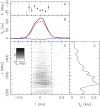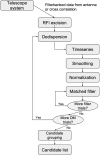Fast radio bursts
- PMID: 39544369
- PMCID: PMC11557685
- DOI: 10.1007/s00159-019-0116-6
Fast radio bursts
Abstract
The discovery of radio pulsars over a half century ago was a seminal moment in astronomy. It demonstrated the existence of neutron stars, gave a powerful observational tool to study them, and has allowed us to probe strong gravity, dense matter, and the interstellar medium. More recently, pulsar surveys have led to the serendipitous discovery of fast radio bursts (FRBs). While FRBs appear similar to the individual pulses from pulsars, their large dispersive delays suggest that they originate from far outside the Milky Way and hence are many orders-of-magnitude more luminous. While most FRBs appear to be one-off, perhaps cataclysmic events, two sources are now known to repeat and thus clearly have a longer lived central engine. Beyond understanding how they are created, there is also the prospect of using FRBs-as with pulsars-to probe the extremes of the Universe as well as the otherwise invisible intervening medium. Such studies will be aided by the high-implied all-sky event rate: there is a detectable FRB roughly once every minute occurring somewhere on the sky. The fact that less than a hundred FRB sources have been discovered in the last decade is largely due to the small fields-of-view of current radio telescopes. A new generation of wide-field instruments is now coming online, however, and these will be capable of detecting multiple FRBs per day. We are thus on the brink of further breakthroughs in the short-duration radio transient phase space, which will be critical for differentiating between the many proposed theories for the origin of FRBs. In this review, we give an observational and theoretical introduction at a level that is accessible to astronomers entering the field.
Keywords: Fast radio burst; Pulsar; Radio astronomy; Transient.
© The Author(s) 2019.
Figures
















References
-
- Abbott BP et al (2017a) Estimating the contribution of dynamical ejecta in the Kilonova associated with GW170817. Astrophys J 850:L39
-
- Abbott BP et al (2017b) GW170817: observation of gravitational waves from a binary neutron star inspiral. Phys Rev Lett 119:161101 - PubMed
-
- Abramowicz MA, Bejger M, Wielgus M (2017) Collisions of neutron stars with primordial black holes as fast radio bursts engines. ArXiv e-prints arXiv:1704.05931
-
- Akahori T, Ryu D, Gaensler BM (2016) Fast radio bursts as probes of magnetic fields in the intergalactic medium. Astrophys J 824:105
-
- Amy SW, Large MI, Vaughan AE (1989) Miscellaneous radio astronomy. Proc Astron Soc Aust 8:172–175
Publication types
LinkOut - more resources
Full Text Sources
